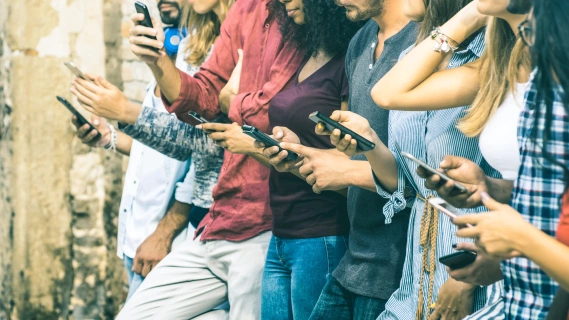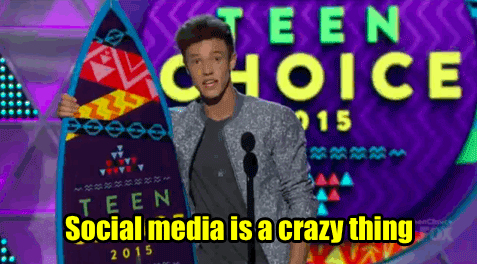Millennials get a bad rap; they’re criticized for having Peter Pan syndrome, refusing to grow up. They want their workspaces to look and feel more like play spaces. And they pay other people to make their meals and drive them around town.
But these “kids” are all grown up now: born between 1981 and 1996, most of them are in their twenties and thirties. They spend $200 billion each year, and they’re flooding all levels of the workforce. Clearly, it pays to understand how to advertise to millennials.
Unfortunately, small businesses are—by and large—behind the eight ball. Only 15 percent of small businesses market directly to millennials. That’s a huge missed opportunity.
As the generation that can’t recall what a pager is, naturally they’re way into their smartphones. Millennials and mobile, it turns out, is not a cliche: 85 percent of millennials have a smartphone. The average millennial checks his or her phone a whopping 157 times per day—five times the rate of older users. And 4 in 10 millennials say they engage with their smartphones more than they do actual humans. Um. Wow.
What's the best way to offer digital marketing to millennials, aka iPhone addicts? If you want to capture their attention, you’ve got to reach your customers where they are—buried deep inside their phones.
Here are nine important ways to get started marketing toward millennials.
Ensure you’re mobile friendly
First and foremost, you have to be ready for mobile users. Your website, emails, landing pages, and all other digital content must be mobile friendly. Here’s why: 61 percent of users are unlikely to return to a mobile site they had trouble accessing, and 40 percent visit a competitor’s site instead. Long gone are the days when users would tolerate clunky website experiences from mobile.
The solution is to employ a design that recognizes whether or not the user is on a desktop or a mobile device, then adjusts the interface—or layout—of the page so the user can interact naturally.
Some things to keep in mind regarding mobile-readiness:
- Adaptive v. responsive design. This is an important one to get right, so you should determine which is right for you. The good news is that if you use WordPress, Squarespace, or similar, it’s quick and painless to get your site mobile-ready. Otherwise, you should schedule a chat with your web developer.
- Design your web pages with mobile users in mind first. Navigation should be clear and consistent. Design for mobile is a big topic, so if you want to know more, here’s what it takes to optimize your website design for mobile.
- Don’t overload your pages with content. And think about how your content will be consumed. For example, any video content should make sense even without audio (remember, many users access their phones on a crowded commuter train).
- Optimize page load speed. Sure, there are a lot of factors that play into load time on a page. Wi-Fi and broadband networks can affect page load. So can the user’s specific mobile device. As the website owner, you have a big role to play, too. You need to be sure that your pages are optimized for the quickest load time possible. This issue is so important that Google has established AMP (Accelerated Mobile Pages), an open-source initiative that enables the creation of websites and ads that are consistently fast, beautiful and high-performing across devices.
- Verify you’re good to go. Google offers a really cool resource for testing your web pages to see just how mobile friendly they are.
Help millennials interact with you on social media
Millennials want to connect with brands they like via social media. Marketingsherpa notes that one in three millennials identify social media as a preferred channel for communicating with businesses. And most social media is consumed on smartphones, which is a huge advantage in advertising to millennials. According to Facebook, 55 percent of millennials use only mobile devices to access their profile or pages.
Millennial users that interact with brands expect to get quick replies to their communication. This means you need to be poised to respond. You gotta be johnny-on-the-spot. Answer direct messages, reply to comments, and treat your followers with respect.
Above all, millennials follow brands on their social channels with purpose. If they followed you, it’s because they are interested in what you have to offer, and they expect you to respect them as your follower. Stick to the rules of the road for the platform you’re using.
Go live and do it right
Social media platforms are tapping into the immersive social media experience through live streaming video. The big players are Facebook Live, Instagram Stories, Video Chat for Snapchat, and Periscope for Twitter.
Live streaming adds urgency to your interactions. When you’re live, your followers will want to be ready so they can watch, react, and comment. In fact, it’s the interaction that makes live streaming so interesting. As you stream, you can respond to your audience in real time.
Word to the wise: square away the tech ahead of time (things like Wi-Fi, camera, and lighting). Brian Fanzo at iSocialFanz has a ton of information about the best equipment for going live.
Live is great for ad-hoc, low-fi video, but when the tech breaks, it can ruin your effort.
That’s why you need to be ready for surprises. It’s live, so anything can happen. Don’t let bumps in the road (like troll comments, technical hiccups, or environmental factors, etc.) get to you. When you roll with little issues, your audience will notice, and they’ll cheer you on.
Poof! Experiment with disappearing content
Younger millennials are all about what’s known as “disappearing media”—platforms such as Snapchat that allow users to send images or videos that live for a few seconds to a day and then are automatically erased. (It's not just for sexting anymore, promise.)
Why would they be into this? It's perceived as more authentic. When you don't fear something will live online forever, you can be a little edgier or try something experimental. It will, after all, be here today and gone tomorrow.
Thirty percent of younger millennials are on Snapchat every day, compared with 19 percent of older millennials (ages 25 to 34), according to a recent Fluent survey. To stand out on Snapchat, focus on being casual and relatable. Millennials are notoriously resistant to the hard sell, but campaigns posting content that’s fun and genuine can help build trust in the brand, which can later convert to sales.
You’ll only have a few seconds to make an impact, so consider creating content that provides a brief behind-the-scenes view of your business, passing the Snapchat account around to a different employee every week, or using creative promotions such as flash coupons, product demos, or teasers for an upcoming event.
It’s all about the image
More than half of millennials in the U.S. are active on Instagram. How can you make your brand a part of your target market’s Insta feed? Encourage them to join in with their own snaps of your product, tagged with a branded hashtag.
One Instagram superstar is Jeni’s Splendid Ice Cream. The shop and online retailer posts photos of its own delicious concoctions (waffles a la mode, anyone?), but its legions of fans really help the brand shine: There are more than 23,000 Instagram posts tagged with #jenisicecream; and well over 20,000 of those are candid photos of sundaes, scoops, ice cream shop selfies, and other Jeni’s images from happy ice cream eaters. Put a sign up in your shop encouraging fans to document their enjoyment, and spread their images widely with your branded hashtag.
Make it easy to buy
Millennials are often criticized for being the “me generation,” obsessed with instant gratification. But can you really blame them? Amazon can deliver virtually anything to your door in an hour. If you want to watch a movie, download it. With smartphones, everything you’d want to buy is at your fingertips; you don’t even need to sit at your computer, let alone trek to a physical store.
On top of the convenience smartphones offer, millennials trust that their phones will serve up the same information as a desktop. This makes them more likely to buy directly from their phone. Consider this stat as a case study in trust: “About two-thirds of younger travelers are comfortable planning an entire trip on a smartphone, compared to one-third of travelers 35 and older.”
So, it’s critical that you find ways to make the buying experience convenient for mobile.
One of the most powerful ways for brands to connect with millennials on mobile is via shopping discounts and special offers.
It turns out that millennials follow brands on social largely for the direct benefits: Sixty-four percent of millennials reported following a brand on Facebook in order to get a coupon or discount on their next purchase.
And it’s not just a social media thing, either. The primary reason millennials sign up for brand emails is to receive discounts. (Another reason to make sure your emails are mobile-friendly!)
Take advantage of the convenience of mobile. When you design your special offers, make it easy to make an impulse buy:
- Be sure your call to action is simple and obvious
- Link directly to a product page
- Leverage purchase history to offer something similar they might like
- Follow up on abandoned shopping cart items
Text, cautiously
If reach is what you’re after, consider Short Message Service (SMS), which sends a text message directly to a consumer’s smartphone. Since text messaging open rates are around 98 percent, this can be a great way to reach almost all your customers immediately.
But beware—there’s as much risk as opportunity here. Many consumers, particularly authenticity-obsessed millennials, could sour on a brand forever if they perceive the SMS as spam. Avoid this pitfall by offering a valuable promotion, keeping the correspondence brief and to the point, and making the promotion exclusive (VIPs only). Include a clear call-to-action (Call now!), a short time frame to motivate your user (Valid until midnight!), and make sure your brand is mentioned. Short and sweet.
Go hyperlocal
Advertisers can take advantage of the built-in GPS and location-sharing capabilities of smartphones to send promotions to users in a given geographic area. This kind of location-based advertising is a popular tool that contributed to a 64 percent increase in average mobile conversion rates compared with average desktop rates.
Facebook, Twitter, and Google allow advertisers to purchase geo-aware ads like coupons for customers located within a five-mile radius of a store, for example. Similarly, geo-fencing allows advertisers to target a location that’s not necessarily their own business and place ads to consumers in that area. For instance, a sneaker store might geo-fence around the local gym. Advertisers can even directly take on their competitors with location-based advertising around a rival’s bricks-and-mortar. This strategy, known as geo-conquesting, poaches customers with better deals and promotions and appears to be successful when used alongside more traditional location-based advertising.
Put it all together: Integrate online and offline experiences
Millennials, more than any other demographic, freely include their online social networks in their physical experiences through updates, photos, and videos. Likewise, they love to engage with the experiences of their network through social media.
For example, take a simple day at the beach: there’s food, sun, and maybe a pickup game of volleyball. Within just a few hours, this experience is chock full of opportunities to share moments via text, picture, and video with friends and followers. It’s also full of opportunity for beachgoers to interact with brands. Maybe a selfie with a hashtag earns them a free burger. Or maybe they use a special Snapchat geofilter for an event happening nearby.
Marketers, ever anxious to make an acronym for a new idea, call this “O2O,” which refers to marketing strategies that promote “Online-to-Offline” or “Offline-to-Online” customer experiences. For example, an O2O experience could look like this: the customer receives a coupon via text message (online) that they can redeem at a brick and mortar business (offline). Or, vice versa, it could be a special photo booth at a busy pedestrian intersection (offline) that encourages people to take a selfie and share it (online).
Through mobile, online interactions can happen anywhere, which means brands must find ways to seamlessly bridge the gap between online and offline experiences.
Key Takeaways
To market toward millennials, you have to understand smartphones from their perspective: Millennials grew up with smartphones. Smartphones act as the hub for their human relationships. They interact with their smartphones more than anything, or anyone, else. Millennials trust their smartphones.
Long story short—and short, these days, is best—millennials live on mobile, so your brand should, too. Keep on top of popular and emerging social media platforms to figure out how best to deliver your message to consumers. Consider how to make your message micro as best fits the mobile medium; and make your content valuable, unique, and genuine.
The good news is that millennials don’t want polish. They want authenticity. So whatever you do with your mobile and social marketing, make sure it’s real. That's best way to advertise to millennials.








